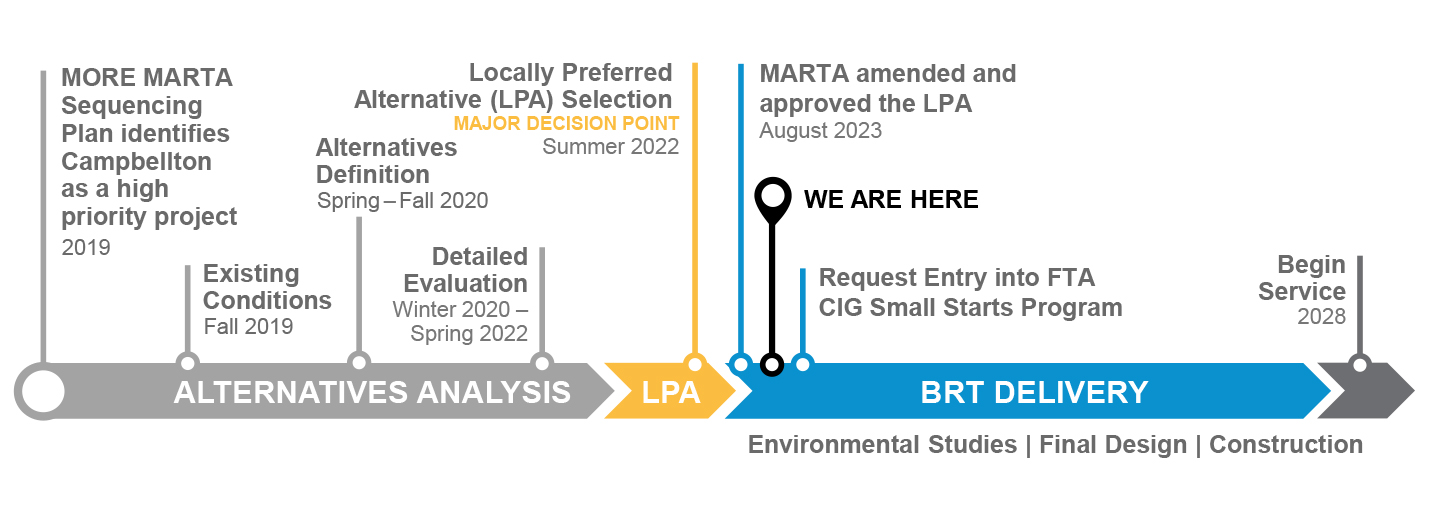Project Overview
Project Goals
Increase access to high-capacity transit
Improve travel times and reliability
Promote transit-supportive development
Project Map

More About Bus Rapid Transit
Learn more about the features of Bus Rapid Transit (BRT), including uses in other cities and testimonials here or watch the short video below.
Activity Timeline
-
Coordinated with stakeholders to refine proposed station area concepts (February 2021-April 2021)
-
Presented results of alternatives analysis for public feedback (June 2021)
-
Addressed feedback and incorporated public comments (June 2021-February 2022)
-
MARTA Board adopted center-running BRT as the Locally Preferred Alternative (LPA) in July 2022
-
Public and stakeholder outreach (Ongoing)
-
Completed Transit-Oriented Development (TOD) Master Plan
-
August 2023 MARTA amended and approved the LPA

AFTER LPA
-
Environmental studies and engineering activities (fall 2023 – winter 2026)
-
Transit-Oriented Development (TOD) Implementation (Ongoing through construction)
-
Final Design and Construction (~2025 – 2028)
-
Begin service (2028)
Federal Funding
The Campbellton Corridor Transit Project is paid for through the More MARTA Atlanta half-penny sales tax, but additional federal funding is also being considered, including the Federal Transit Administration (FTA)’s Small Starts Discretionary Grant Program, a Capital Investment Grant. The City of Atlanta submitted a Multimodal Project Discretionary Grant (MEGA) application to USDOT in May 2022 to implement center-running gold standard BRT for the Campbellton Community Investment Corridor.
What is the Federal Transit Administration and the Small Starts Discretionary Grant Program?
The Federal Transit Administration (FTA) is an agency within the United States Department of Transportation (DOT) that provides financial and technical assistance to local public transportation systems including buses, subways, light rail, commuter rail, trolleys, and ferries.
The FTA oversees grants to state and local transit providers primarily through its 10 regional offices. These providers are responsible for managing their programs in accordance with federal requirements, and the FTA is responsible for ensuring that grantees follow federal mandates along with statutory and administrative requirements. The FTA also oversees safety measures and helps develop next-generation technology research.
The Small Starts Grant Agreement (SSGA) is provided as part of the FTA’s Capital Investment Grants (CIG) program, which is a discretionary grant program which funds transit capital investments, including heavy rail, commuter rail, light rail, streetcars, and bus rapid transit.
In 2008, nearly one half of the FTA’s pipeline of projects were light rail transit (LRT), and there were only seven bus rapid transit (BRT) projects being considered for funding. Since 2018, FTA has funded 23 BRT projects and as of January 2022, almost two-thirds of the pipeline are BRT projects. Meanwhile, only six light rail projects are under development in the US.

Land Use and Design
MARTA is also considering opportunities for investment, such as underutilized and vacant properties in the corridor that can support new investment in Transit-Oriented Development (TOD). Transit station locations were identified by studying previous plans and studies along the corridor, analyzing community feedback and existing/future zoning land use and activity centers to meet the connectivity and mobility needs in the corridor – bus route 83 has performed as one of the top three routes within the system for the past decade.
Public Feedback
The public provided their feedback on land-use barriers for the Campbellton Corridor Transit Project. Key components include:
-
Love that rapid transit will enhance connectivity
-
Wider, safer sidewalks are a priority
-
Implement rapid transit as fast as possible
-
Stakeholders want to see the Livable Centers Initiative (LCI) plan visions come to fruition. Projects should help build neighborhoods
-
Many stakeholders in the area are open to redevelopment
-
There should be a range of policy options and collaborative partners
-
The community is excited and optimistic about transit

Transit-Oriented Development
Transit-oriented or “TOD” means development around transit stations that is compact, vibrant, pedestrian-friendly, and seamlessly integrated with transit. There are four principles of TOD:
While the overall scale of development around each station may vary, successful TODs share several key concepts:
-
Development adjacent to the station is dense and compact compared to its surroundings, and includes a rich mix of land uses at a variety of affordability levels so people can work, shop, or go to school within walking distance of transit
-
Development of a great public realm, walkability with sidewalks, amenities such as lighting, street trees, seating, or bicycle transit, and a grid of streets
-
While TOD is centered around a transit station, it also integrates a variety of other mobility options, including pedestrian, bicycle, and vehicular transportation. Transit does not mean “no cars,” but it does require less parking than similar development in non-transit-oriented locations
Key components from land use/TOD analyses:
-
Corridor Assessment evaluated the potential for TOD along the corridor
-
Station-Area Analysis evaluated barriers and opportunities at each potential station
-
Land-Use Framework established development character and scale
-
Market Evaluation studied development opportunities and potential to prioritize station development and phasing
-
Station-Area Concept Plans identified framework plans for future TOD development around station areas
-
Catalyst Stations identify key stations to focus early development along the corridor and catalyze economic development paired with more detailed station plans
-
Implementation Strategies identified necessary policies and strategies to implement successful TOD along Campbellton Corridor
Subscribe
We’re on all major social media platforms. Share your contact information with us to receive the most recent project information.